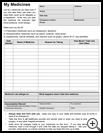
Tuberculin Purified Protein Derivative (TB Test)
too-BER-kyoo-lin PYOO-ri-fyd PROH-teen de-RIV-a-tiv
________________________________________________________________________
KEY POINTS
- A healthcare provider will prick the surface layer of the skin on your forearm with a special needle to test for tuberculosis (TB) infection.
- It is very important that you return to your healthcare provider in 2 to 3 days after the test.
- This medicine may cause unwanted side effects. Tell your healthcare provider if you have any side effects that are serious, continue, or get worse.
- Tell all healthcare providers who treat you about all the prescription medicines, nonprescription medicines, supplements, natural remedies, and vitamins that you take.
________________________________________________________________________
What are other names for this medicine?
Type of medicine: diagnostic agent
Generic and brand names: tuberculin purified protein derivative; Tubersol; Aplisol; Tuberculin Tine Test
What is this medicine used for?
This medicine is used to test for tuberculosis (TB) infection.
This medicine may be used to treat other conditions as determined by your healthcare provider.
What should my healthcare provider know before I take this medicine?
Before receiving this medicine, tell your healthcare provider if you have ever had:
- An allergic reaction to any medicine
- A BCG vaccine
- A weakened immune system from cancer treatment, diseases such as HIV/AIDS, or from taking steroid medicines or medicines to prevent organ transplant rejection
- A positive TB test or TB infection
- Cancer
- Kidney disease
- Skin problems such as eczema or severe burns
Tell your healthcare provider if you have had a vaccine for chickenpox, influenza, measles, mumps, rotavirus, smallpox, typhoid, yellow fever, or zoster in the past 4 to 6 weeks. Also, tell your healthcare provider if you have recently had any infection such as chickenpox, measles, mumps, or the flu.
Females of childbearing age: Tell your healthcare provider if you are pregnant or plan to become pregnant. It is not known whether this medicine will harm an unborn baby. Do not breast-feed while taking this medicine without your healthcare provider's approval.
How do I use it?
A healthcare provider will prick the surface layer of the skin on your forearm with a special needle. You must return to your healthcare provider in 2 or 3 days after the test so the size of the skin reaction can be measured. Keep all appointments. If the bump is big, you have a positive reaction to tuberculosis. If there is no bump you probably do not have TB.
What should I watch out for?
Do not cover the injection spot with a bandage. Do not scratch your arm. If it itches, put a cold washcloth on it. When you wash it, pat your arm dry rather than rubbing it.
It is very important that you return to your healthcare provider in 2 to 3 days after the test.
If you need emergency care, surgery, lab tests, or dental work, tell the healthcare provider or dentist you have received this medicine.
What are the possible side effects?
Along with its needed effects, your medicine may cause some unwanted side effects. Some side effects may be very serious. Some side effects may go away as your body adjusts to the medicine. Tell your healthcare provider if you have any side effects that continue or get worse.
Life-threatening (Report these to your healthcare provider right away. If you cannot reach your healthcare provider right away, get emergency medical care or call 911 for help.): Allergic reaction (hives; itching; rash; trouble breathing; chest pain or tightness in your chest; swelling of your lips, tongue, and throat).
Serious (Report these to your healthcare provider right away.): High fever (over 103°F, or 39.5°C), severe dizziness or fainting, skin blistering or peeling.
Other: Pain at the site of the shot, itching, minor rash.
What products might interact with this medicine?
When you take this medicine with other medicines, it can change the way this or any of the other medicines work. Nonprescription medicines, vitamins, natural remedies, and certain foods may also interact. Using these products together might cause harmful side effects. Tell your healthcare provider if you are taking:
- Corticosteroids such as betamethasone, cortisone, dexamethasone, fludrocortisone, hydrocortisone (A-Hydrocort, Cortef), methylprednisolone (Medrol, Solu-Medrol), prednisolone (Omnipred, Orapred, Prelone), prednisone (Prednisone Intensol), and triamcinolone (Aristospan, Kenalog)
- Immunosuppressants such as azathioprine (Azasan, Imuran), cyclosporine (Gengraf, Neoral, Sandimmune), sirolimus (Rapamune), and tacrolimus (Astagraf, Prograf, Protopic)
Keep a record of all vaccines received and when you received them.
If you are not sure if your medicines might interact, ask your pharmacist or healthcare provider. Keep a list of all your medicines with you. List all the prescription medicines, nonprescription medicines, supplements, natural remedies, and vitamins that you take. Be sure that you tell all healthcare providers who treat you about all the products you are taking.
This advisory includes selected information only and may not include all side effects of this medicine or interactions with other medicines. Ask your healthcare provider or pharmacist for more information or if you have any questions.
Keep all medicines out of the reach of children.
Do not share medicines with other people.
Last modified: 2016-10-06
Last reviewed: 2015-01-13

